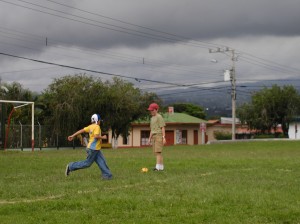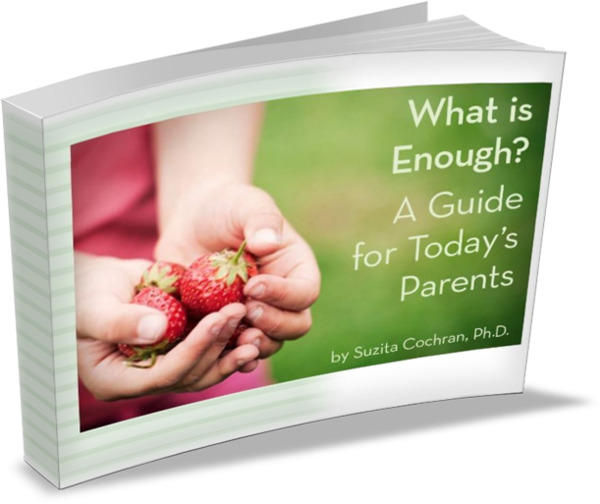 Two summers ago our family traveled to central Costa Rica for a month to live with a local family and learn Spanish at a language school. Our kids were 11, 9 and 6 at the time.
Two summers ago our family traveled to central Costa Rica for a month to live with a local family and learn Spanish at a language school. Our kids were 11, 9 and 6 at the time.
I’d conceived of the notion of learning Spanish as a family and thought we should do it during the summers when Todd, being a professor, has some time flexibility. I loved the idea of becoming fluent in a second language, while showing our kids different cultures. But, we didn’t just want Spanish by the beach, margaritas in hand. We wanted more of an immersion experience.
Todd and I had taken 5 months of intensive Spanish before we set off. Our sons had taken a year-long, after-school Spanish class, and Annie had merely listened to Spanish CDs and watched Muzzy, the BBC kids’ language program. So you can see, we had a lot to learn.
As with all grand plans, this one looked much easier on paper than it was “up close and personal.” I am writing about it now with the perspective of time, but want to use a smattering of my emails from the trip to underscore the intensity and vibrancy of the experience.
Here was my first email home:
I don’t have a ton of time, but I wanted to jot down some first impressions of our Costa Rican experience. First, I’m so glad we spent the time and energy on all those Spanish classes last summer and fall because, contrary to what many Americans told us, we are not running into many English speakers here. This is likely because we are off the tourist path, at least while we attend Spanish language school.
Our homestay mother does not speak any English, the bus drivers don’t speak English, our Spanish teacher doesn’t speak English. Our new friends we met at the local park when we asked them to play frisbee, don’t speak English. We are immersed in another culture!
This of course is what I wanted and hoped for in this trip. However, I’d like to clarify that taking 4 hours of Spanish every morning, speaking Spanish at home and out and about, attempting to order food for 5 that will be eaten, and making sure the kids don’t get mown down by a car while crossing the hectic streets is not a vacation. It’s an adventure, but not what one would call relaxing.
That first week was pure survival. Some things we learned:
- Don’t just go for one week or you’ll never exit survival mode.
- Maintain low expectations and offer the family frequent treats during that first week.
- Let the kids watch some tv, at least it’s in Spanish.
Here’s what I wrote about our Spanish language learning after week 2:
Todd and I are definitely learning more Spanish and have ample opportunity to practice it. For those of you who know Spanish already, we are currently swimming in a deep pool of the subjunctive tense and will be in these waters for a while. But it’s been so helpful to study and practice with a partner.
As for our kids learning Spanish, the jury is still out. Todd and I have contemplated this and have generated a hypothesis. Numerous people told us the kids would learn Spanish in no time if they traveled to a Spanish-speaking country and spent time with local kids. We are now assuming the definition of “no time” is one year. To be honest, this feels like less of a surprise to me than to Todd. He’s always been an optimistic soul.
My hope was to come down here and show the kids a very different culture than their own. I wanted them to know that not all places are like Boulder. Then I wanted them to have contacts with kids their ages from another culture, to get an up close sense of the differences. I also wanted them to understand personally how hard it is for people who immigrate to our country. I hoped that experiencing these things would then give the kids a motivation for learning Spanish they didn’t have before. Then, it was icing on the cake for me if the kids learned a ton of Spanish as well.
After nearly two weeks, I’d say that there is no icing on this cake. The kids will not be learning a ton of Spanish in one month, unless something very unexpected happens next week. That’s not to say they aren’t learning anything. Annie regularly states, “Tengo hambre” before meals, and Stephen is improving his verb conjugations. They all have great natural accents. But, the moral of the story is that this is the first (hopefully) of many of these trips that will move us toward fluency as a family.
5 Big Picture Lessons Gleaned from our Spanish Immersion Experience:
1. Learning a language is challenging however and wherever you do it. The kids had 4 hours of Spanish daily in Costa Rica with one substantial break during the 4 hours. However, learning a language is not altogether different from say, learning math. Would you expect a child to sit for 4 hours every morning to learn math?
2. Schools in Central America are still taught on a strict Catholic school model. Kids are expected to remain seated quietly at their desks, listen to the teacher, and copy a lot down. It’s not the active, creativity-based model you see in American elementary schools today. Our Costa Rican Spanish teachers taught us the way they’d been taught. We practically had to bribe them to take the kids on a walk or to the store.
3. Make sure the kids have activities each day at which they feel competent. For example, after Spanish school most days we went to the central park to play soccer with some of the local kids. Stephen and Daniel love and are skilled at soccer. One doesn’t have to speak Spanish to play soccer. Therefore, soccer helped them recover from the tough mornings of Spanish school.
Annie’s comfort activity turned out to be playing with 1½ year-old Sofia, the granddaughter of our Costa Rican host mother. Sofia adored Annie and it didn’t matter that Annie couldn’t speak Spanish because Sofia couldn’t either. Annie picked up the majority of her Spanish while playing with Sofia and being spoken to in Spanish by Sofia’s grandma.
4. Bring something the kids can share with other kids, which doesn’t require much language. We brought cat’s cradle hand strings which we made ourselves. When we met a new kid, we gave him a string, and our kids taught him various tricks with it. As it turned out many Costa Rican kids were familiar with these and showed us some figures we’d never seen.
5. If you happen to have a grandma who’s fluent in Spanish, definitely bring her along! Ours couldn’t join us the entire time, but when there, smoothed out many a cross-cultural rough edge.
One final lesson:
Your child may do fine with milk at home but then throw up directly after breakfast for 2 days in a row in a foreign country.
My quote:
Least favorite verbs I had to learn on this trip: vomitar and tolerar. As in, Daniel vomito again this morning. I don’t think his estomago can tolera milkshake smoothies for breakfast anymore. (Had to say this to our host mother during week 2.)
In next week’s post, read about what our kids actually took away from their Costa Rican experience (since you now know it wasn’t fluency in Spanish!)

 Sweet Spots: Helping Your Kids Find ENOUGH in Their Lives.
Sweet Spots: Helping Your Kids Find ENOUGH in Their Lives.


Wow, what a great and unique experience. Thanks for sharing!
You’re welcome! I hope you’ll like next week’s too.
Suzita
This has been my dream for so many years. My kids are now 11 and 13, I may have to wait a few more years still. Thanks for sharing your story.
Hi- We live in Denver and I have been researching how to do something similar with my family. My boys are currently 9 and 10 and I was hoping to go on the adventure when they are 11 and 12. Would love to hear more from you!
Debbie
Very soon this site wil be famous amid all blog visitors, due to it’s pleasant articles